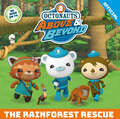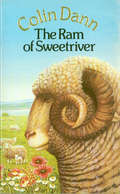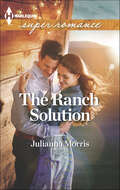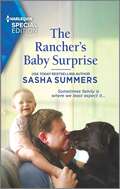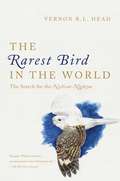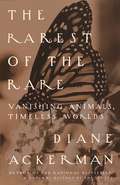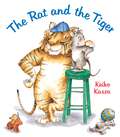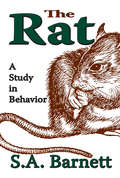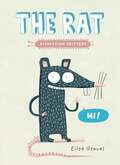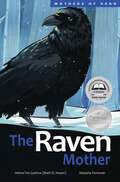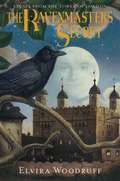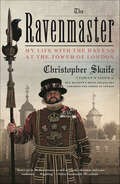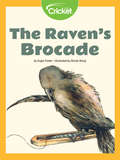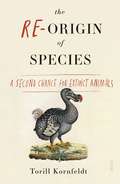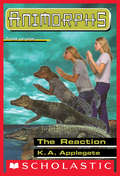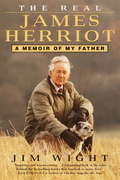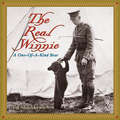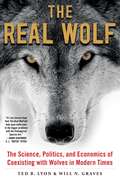- Table View
- List View
The Rainforest Book (Conservation for Kids)
by Charlotte MilnerEmbark on a journey through the magical world of the rainforest and introduce little nature-lovers to an enchanting, yet threatened, tropical worldStep inside the fascinating world of tropical rainforests where you&’ll encounter an enormous variety of flora and fauna! This gorgeously illustrated picture book is a wonderful way to introduce kids to the world of nature and conservation.The rainforests are bursting with life! Sweep aside the liana vines, hop over the giant roots of the kapok tree, and discover magnificent tigers roaming the jungle. In this enchanting children&’s book, you&’ll discover amazing rainforest animals, learn about the diverse range of life-giving plants, and find out why the Amazon rainforest is known as the &“lungs&” of our Earth. This colorful children&’s book captures the spirit of the rainforest through its beautifully detailed illustrations by Charlotte Milner. It has simple, clear text that is accessible to less confident readers but a strong message about deforestation and climate change will captivate older readers too.Let&’s Explore!Venture into the depths of the tropical rainforest and uncover riveting facts about these marvels of nature. Did you know that the air in a rainforest feels wet because trees and plants release water that they don&’t need into the air? And that over half of our planet&’s wildlife live in the rainforest? The world&’s rainforests are packed with amazing creatures! From the nocturnal kinkajou to the stinky rafflesia flower – there is plenty to discover in this plant and animal encyclopedia. Perfect for kids aged 5-9 years, it also includes a fun gardening activity section with instructions on how to grow your own miniature rainforest at home.Complete the Series:Following on from The Bee Book, The Sea Book, and The Bat Book, these engaging plant and animal books highlight the important ecological issues faced by our planet. It&’s perfect for parents who want to encourage children to learn about ecology and remind them that it is up to us to care for our planet.
The Rainforest Rescue (Octonauts Above & Beyond #2)
by Official OctonautsThe Octonauts return with a new global mission - on land! Enlisting their intrepid friends from around the world as Octo-agents - and equipped with a new fleet of land-based Terra Gups - the Octonauts' work is as vital as ever. They will explore far-flung environments, rescue animals that need their help and protect the land and all living creatures.Featuring everyone's favourites from the original series, such as Captain Barnacles and Kwazii Cat, OCTONAUTS: ABOVE AND BEYOND also introduces lovable new characters like Paani, the water scientist monkey - not to mention their cool new vehicle, the Octo-Ray! Together the crew embark on exciting missions to save animals everywhere who need their help.Each book includes a fact file about some of the amazing creatures featured in the story. Look out for book 2 in October 2023.
The Ram Of Sweetriver
by Colin DannThe Sweetriver flock has survived the terrible storm which destroyed their valey. But can they survive the long, hungry journey to find new pastures? Jacob, the ram of Sweetriver, must use every ounce of his courage to fend off danger and keep the flock together. But his enemies are not only outside the flock . . .
The Ranch Solution
by Julianna MorrisTrading his laptop for a...saddle?Widower Jacob O'Donnell has to snap his teen daughter out of her rebellious ways. And his last resort to do so means temporarily swapping his Seattle boardroom for a Montana ranch. It should be simple, but nothing prepares him for the realities of a working ranch...or for Mariah Weston. This rugged country can only be paradise to someone like Mariah, whose can-do attitude and sizzling-hot temper throw Jacob harder than any horse ever could.Yet maybe a strong woman like Mariah can get through to his daughter. One thing is for sure-Mariah is definitely getting through to Jacob! And the closer she gets to his heart, the more Jacob wants what he knows might be impossible.
The Rancher and the Vet (Fatherhood)
by Julie BensonCowboy, Come HomeLeaving his Colorado hometown was the second hardest thing Reed Montgomery ever did-the first was breaking up with Avery McAlister, his high school sweetheart. Now his Western roots are calling the citified CEO back to his family ranch to be surrogate dad to his niece, Jess. Of course, he can't help being pulled back into Avery's world.Keeping her financially strapped animal shelter open is Avery's first priority-her second turns out to be helping Reed with his parenting skills. They may be bonding, but her former flame still has some serious explaining to do about the secret that drove him away.The ghosts of the past and a rekindled desire bring Reed and Avery ever closer together. But will Reed embrace his future...as a cowboy, a father and as the man for Avery?
The Rancher's Baby Surprise: A Baby For The Deputy The Cowboy's Triple Surprise A Cowboy To Call Daddy Rodeo Rancher (Texas Cowboys & K-9s #3)
by Sasha SummersWith a wounded body and a broken spiritHe needs his best friend more than ever Former soldier John Mitchell has come home after being discharged and asks his best friend, Natalie, to help him decompress. They&’re both in for a shock when a precious baby girl is dropped on Natalie&’s doorstep—and John is the father! Now John needs Natalie&’s help more than ever. But Natalie has been in love with John forever. How can she help him find his way to being a family man if she&’s not part of that family?From Harlequin Special Edition: Believe in love. Overcome obstacles. Find happiness.Texas Cowboys & K-9sBook 1: The Rancher's Forever FamilyBook 2: Their Rancher ProtectorBook 3: The Rancher's Baby Surprise
The Random House Book of Horse Stories
by Felicity TrotmanHere's an enchanting collection of magical talking horses, mythical flying horses, and loyal farm horses that will have the equine set champing at the bit for more.
The Rarest Bird in the World: The Search for the Nechisar Nightjar
by Vernon R HeadPart detective story, part love affair, and pure adventure storytelling at its best, a celebration of the thrill of exploration and the lure of wild places during the search for the elusive Nechisar Nightjar. In 1990, a group of Cambridge scientists arrived at the Plains of Nechisar in Ethiopia. On that expedition, they collected more than two dozen specimens, saw more than three hundred species of birds, and a plethora of rare butterflies, dragonflies, reptiles, mammals, and plants. As they were gathering up their findings, a wing of an unidentified bird was packed into a brown paper bag. It was to become the most famous wing in the world. This wing would set the world of science aflutter. Experts were mystified. The wing was entirely unique. It was like nothing they had ever seem before. Could a new species be named based on just one wing? After much discussion, a new species was announced: Nechisar Nightjar, or Camprimulgus Solala, which means "only wing." And so birdwatchers like Vernon began to dream. Twenty-two years later, he joins an expedition of four to find this rarest bird in the world. In this gem of nature writing, Vernon captivates and enchants as he recounts the searches by spotlight through the Ethiopian plains, and allows the reader to mediate on nature, exploration, our need for wild places, and the human compulsion to name things. Rarest Bird is a celebration of a certain way of seeing the world, and will bring out the explorer in in everyone who reads it.
The Rarest of the Rare: Vanishing Animals, Timeless Worlds
by Diane AckermanThe renowned author of A Natural History of the Senses takes readers in search of the "rarest of the rare," species likely to disappear before most of us have ever seen them. From Brazil to the Pacific to Japan, Ackerman shares her concern at the animals' plight, rejoices at the chance to experience them, and cheers those who work to save these fantastic creatures.
The Rat and the Tiger (Houghton Mifflin Leveled Library: Paperback Plus: Theme: Big Ser.)
by Keiko KaszaTiger has been acting like a bully, but Rat shows him how important it is to share and play fair. Rat and Tiger are best friends. They have lots of fun playing together, even though when they play cowboys, Rat always has to be the bad guy. When they share a snack, Rat always gets the smaller piece. But one day, Tiger takes the bullying too far, and Rat decides that he&’s not going take it anymore. Rat stands up for himself and refuses to be Tiger&’s friend until Tiger learns to play fair and square. With appealing illustrations and a simple text, Keiko Kasza delivers an important message about friendship in this heartwarming story.
The Rat: A Study in Behavior
by S. A. BarnettThe laws of animal behavior have been revised and revealed through research performed by zoologists, physiologists and experimental psychologists. Each has contributed much. Their main meeting ground has been the study of mammals, especially rats. This classic book is unique in bringing together the principal conclusions of these researchers in a compact, well illustrated, and lucid form.The author himself made important original contributions to wild rat behavior; his account of "white rat psychology" and of relevant work on other species is equally authoritative. Experience as a teacher enabled him to write an unusually logical and comprehensive text, suitable for students of zoology, psychology and medicine.This book belongs to no particular school of biology or psychology. Rather it admits the work of all schools and strict adherence to none. The principal topics covered include: movement in the living space; feeding behavior; social and reproductive behavior; the analysis of "instinct"; the analysis of learned behavior; "motivation" and "drive"; the brain and behavior. The book includes a full, carefully selected bibliography, current up to the time of original publication of the original edition.
The Rat: The Disgusting Critters Series (Disgusting Critters)
by Elise GravelOne in a series of humorous books about disgusting creatures, The Rat is a look at the black rat. It covers such topics as the rat's long, agile tail (it's good for balancing and picking noses), long teeth (they can chew through anything, including books) and disgusting taste in food (delicious electrical wires in tomato sauce, anyone?). Although silly and off-the-wall, The Rat contains factual information that will both amuse and teach at the same time.
The Raven Mother (Mothers of Xsan)
by Hetxw'ms Gyetxw Huson★ Starred selection for CCBC's Best Books for Kids & Teens 2023! Hoarders. Scavengers. Clever foragers. Bringers of new life. Ravens have many roles, both for the land and in Gitxsan story and song. The sixth book in Hetxw'ms Gyetxw (Brett D. Huson)’s Mothers of Xsan series transports young readers to Northwestern British Columbia, where they will learn about the traditions of the Gitxsan, the lives of ravens, and why these acrobatic flyers are so important to their ecosystem. Follow along as Nox Gaak, the raven mother, teaches her chicks what they need to survive with the help of her flock.
The Raven Mother (Mothers of Xsan)
by Hetxw’ms Gyetxw Huson★ Starred selection for CCBC's Best Books for Kids & Teens 2023! Hoarders. Scavengers. Clever foragers. Bringers of new life. Ravens have many roles, both for the land and in Gitxsan story and song. The sixth book in Hetxw'ms Gyetxw (Brett D. Huson)&’s Mothers of Xsan series transports young readers to Northwestern British Columbia, where they will learn about the traditions of the Gitxsan, the lives of ravens, and why these acrobatic flyers are so important to their ecosystem. Follow along as Nox Gaak, the raven mother, teaches her chicks what they need to survive with the help of her flock.
The Raven Mother (Mothers of Xsan)
by Hetxw’ms Gyetxw Huson★ Starred selection for CCBC's Best Books for Kids & Teens 2023! Hoarders. Scavengers. Clever foragers. Bringers of new life. Ravens have many roles, both for the land and in Gitxsan story and song. The sixth book in Hetxw'ms Gyetxw (Brett D. Huson)&’s Mothers of Xsan series transports young readers to Northwestern British Columbia, where they will learn about the traditions of the Gitxsan, the lives of ravens, and why these acrobatic flyers are so important to their ecosystem. Follow along as Nox Gaak, the raven mother, teaches her chicks what they need to survive with the help of her flock.
The Ravenmaster's Secret
by Elvira WoodruffIt's 1735. Forrest Harper's life inside the Tower of London consists of three ways to pass the time: chores, chores, and more chores. His only friends are the spirited ravens he tends with his father. So when vicious Scottish Rebels are captured, Forrest can't wait to prove his courage by standing guard. If only Forrest's prisoner hadn't turned out to be a noble and daring girl named Maddy. And if only Maddy wasn't about to be executed...
The Ravenmaster: My Life with the Ravens at the Tower of London
by Christopher SkaifeThe first behind-the-scenes account of life with the legendary ravens at the world’s eeriest monumentThe ravens at the Tower of London are of mighty importance: rumor has it that if a raven from the Tower should ever leave, the city will fall.The title of Ravenmaster, therefore, is a serious title indeed, and after decades of serving the Queen, Yeoman Warder Christopher Skaife took on the added responsibility of caring for the infamous ravens. In The Ravenmaster, he lets us in on his life as he feeds his birds raw meat and biscuits soaked in blood, buys their food at Smithfield Market, and ensures that these unusual, misunderstood, and utterly brilliant corvids are healthy, happy, and ready to captivate the four million tourists who flock to the Tower every year.A rewarding, intimate, and inspiring partnership has developed between the ravens and their charismatic and charming human, the Ravenmaster, who shares the folklore, history, and superstitions surrounding the ravens and the Tower. Shining a light on the behavior of the birds, their pecking order and social structure, and the tricks they play on us, Skaife shows who the Tower’s true guardians really are―and the result is a compelling and irreverent narrative that will surprise and enchant.
The Ravenmaster: My Life with the Ravens at the Tower of London
by Christopher Skaife“Packed with insight and anecdote [this memoir] brings the Tower ravens to vivid life.” —George R .R. Martin, #1 New York Times–bestselling author of A Game of ThronesThe ravens at the Tower of London are of mighty importance: rumor has it that if a raven from the Tower should ever leave, the city will fall.The title of Ravenmaster, therefore, is a serious title indeed, and after decades of serving the Queen, Yeoman Warder Christopher Skaife took on the added responsibility of caring for the infamous ravens. In The Ravenmaster, he lets us in on his life as he feeds his birds raw meat and biscuits soaked in blood, buys their food at Smithfield Market, and ensures that these unusual, misunderstood, and utterly brilliant corvids are healthy, happy, and ready to captivate the four million tourists who flock to the Tower every year.An intimate, and inspiring partnership has developed between the ravens and their human, the Ravenmaster, who shares the folklore, history, and superstitions surrounding the ravens and the Tower. Shining a light on the behavior of the birds, their pecking order and social structure, Skaife shows who the Tower’s true guardians really are—and the result is a compelling and irreverent narrative that will surprise and enchant.“An unending fount of raven lore.” —Petra Mayer, NPR“A beguiling, fascinating, and highly amusing account of the strangely magical birds.” —Helen MacDonald, The Atlantic“A natural storyteller, Skaife writes with affection and insight.” —PD Smith, The Guardian“Skaife] fill[s] in the story with scads of local color.” —Peter Lewis, The Boston Globe“Splendid.” —Booklist, starred review“A rollicking tale fit for nearly any armchair adventurer.” —Publishers Weekly
The Ravens Brocade
by Eugie FosterIn this Japanese folktale, Binbou is a poor man. After saving a raven, he meets a beautiful woman who wishes to marry him. What measures will Binbou take to care for his new wife? Will his greed drive her away?
The Re-Origin of Species: A second chance for extinct animals
by Torill KornfeldtFrom the Siberian permafrost to the Californian desert, scientists across the globe are working to resurrect all kinds of extinct animals, from ones that just left us to those that have been gone for many thousands of years. Their tools in this hunt are the fossil record and cutting edge genetic technologies.
The Reaction: The Secret; The Android; The Forgotten; The Reaction (Animorphs #12)
by K. A. ApplegateRachel's got some pretty strange stuff happening. She can't control her morphing. One minute, she's doing homework. The next, she's morphing a full-grown crocodile, and -- without returning to human form -- she becomes an elephant. That's when the floor gives way and Rachel finds herself looking up at what used to be the kitchen ceiling.What's going on? No one's sure, but Rachel and the other Animorphs have to figure it out -- quickly. Because if someone sees Rachel's out-of-control morphing, the other Animorphs are in for some serious trouble.
The Real James Herriot: A Memoir of My Father
by James WightNo one is better poised to write the biography of James Herriot than the son who worked alongside him in the Yorkshire veterinary practice when Herriot became an internationally bestselling author. Now, in this warm and poignant memoir, Jim Wight talks about his father--the beloved veterinarian whom his family had to share with half the world.Alf Wight (aka James Herriot) grew up in Glasgow, where he lived during a happy rough-and-tumble childhood and then through the challenging years of training at the Glasgow Veterinary College. The story of how the young vet later traveled to the small Yorkshire town of Thirsk, aka Darrowby, to take the job of assistant vet is one that is well known through James Herriot's internationally celebrated books and the popular All Creatures Great and Small television series. But Jim Wight's biography ventures beyond the trials and tribulations of his father's life as a veterinarian to reveal the man behind the stories--the private individual who refused to allow fame and wealth to interfere with his practice or his family. With access to all of his father's papers, correspondence, manuscripts, and photographs--and intimate remembrances of all the farmers, locals, and friends who populate the James Herriot books--only Jim Wight could write this definitive biography of the man who was not only his father but his best friend.NOTE: This edition does not include a photo insert.
The Real Nurse
by Tamorin LaversEvelyn harbours a heartfelt dream of becoming a nurse, healing the world one tender touch at a time. On the other paw, Khan the cat yearns for a life filled with thrilling adventures. In this enchanting picture book, dive into the delightful days of ‘dress-ups,’ where every outfit unveils a world of wonder, nurturing compassion, and sparking joy in little hearts. Together, Evelyn and Khan discover that imagination can stitch the realms of care and adventure into a tapestry of magical memories.
The Real Winnie: A One-Of-A-Kind Bear
by Val ShushkewichThe story of Winnie, the real Canadian bear that captured the heart of Christopher, son of A.A. Milne, and became immortalized in the Winnie the Pooh stories, is told against the backdrop of the First World War. <P><P>In August 1914, a Canadian soldier and veterinarian named Lieutenant Harry Colebourn, en route to a training camp in Quebec, purchased a black bear cub in White River, Ontario, which he named Winnipeg. <P><P>First a regimental mascot for Canadians training for wartime service, Winnie then became a star attraction at the London Zoo, and ultimately inspired one of the best-loved characters in children’s literature. <P><P>For those many generations of readers who adored Winnie the Pooh, and for those intrigued by the unique stories embedded in Canadian history, this book is a feast of information about a one-of-a-kind bear set during a poignant period of world history. <P><P>Today Winnie "lives on" at the London Zoo, in White River and in Winnipeg. Her remarkable legacy is celebrated in many ways – from statues and plaques to festivals and museum galleries.
The Real Wolf: The Science, Politics, and Economics of Coexisting with Wolves in Modern Times
by Ted B Lyon Will N. GravesThe Real Wolf is an in-depth study of the impact that wolves have had on big game and livestock populations as a federally protected species. Expert authors Ted B. Lyon and Will N. Graves, sift through the myths and misinformation surrounding wolves and present the facts about wolves in modern times. Each chapter in the book is meticulously researched and written by authors, biologists, geneticists, outdoor enthusiasts, and wildlife experts who have spent years studying wolves and wolf behavior. Every section describes a unique aspect of the wolf in the United States. The Real Wolf does not call for the eradication of wolves from the United States but rather advocates a new system of species management that would allow wolves, game animals, and farmers to coexist with one another in a way that is environmentally sustainable.Contributors to this groundbreaking environmental book include:Cat Urbigkit, award-winning wildlife author and photographerDr. Valerius Geist, foremost expert of big game in North AmericaMatthew Cronin, environmental researcher and geneticistRob Arnaud, president of Montana Outfitters and Guides Association

